填坑 | React Context原理
很久没有更新我的 从0带你实现 React 18 专栏了,还剩下两个部分,一个是Context,一个是Suspense&unwind。这次来说说Context原理
Context的使用大家肯定不陌生了,被Context包裹的子节点可以通过 Consumer 或者 useContext获取Context的共享值,那么这是如何实现的呢?
我们简单的画图说明
一段简单的DOM结构:
<Context_A.Provider value={A1}><FunctionComponet1> // A1<Context_A.Provider value={A2}><FunctionComponet2> // A2<FunctionComponet3> // A2</Context_A.Provider></FunctionComponet1><Context_B.Provider value={B1}> <FunctionComponet4> // B1</Context_B.Provider>
</Context_A.Provider>其对应的Fiber结构如下所示:
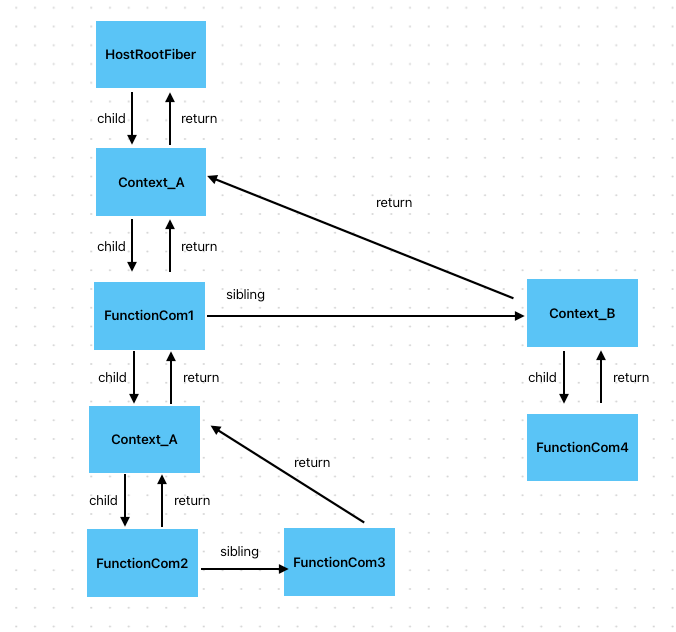
可以看到,最外层有Context_A包裹,内部包含函数组件1 和 Context_B, 而函数组件1再次包含Context_A, Context_A 包含函数组件2 3 。 Context_B 包含函数组件4
在这四个函数组件内,其中 组件1可以拿到 A1的值,组件2 3 可以拿到 A2的值,也就是内层Context_A的值,组件4可以拿到B1, Context是可以层层嵌套的。
你也许会发现,嵌套Context的Value类似于栈,每经过一层嵌套就把最新的值Push到栈中,而回溯的时候每回溯到一层Context就把顶部的值Pop,React中就是这么实现的
React对于不同的Context,比如Context A , B 共用了一个Stack,因为Fiber节点的遍历是深度优先的,递归的顺序是稳定的,也就是说,当我向下递的顺序为 Context A -> Context B -> Context C的时候,向上回溯(归)的顺序一定是 Context C -> Context B -> Context A 天然的保证了某个节点在 递,归的两个阶段,压入栈和弹出栈的值是同一个。
当向下递到第一层 Context_A 时,会将当前Context_A的value A1 压入栈
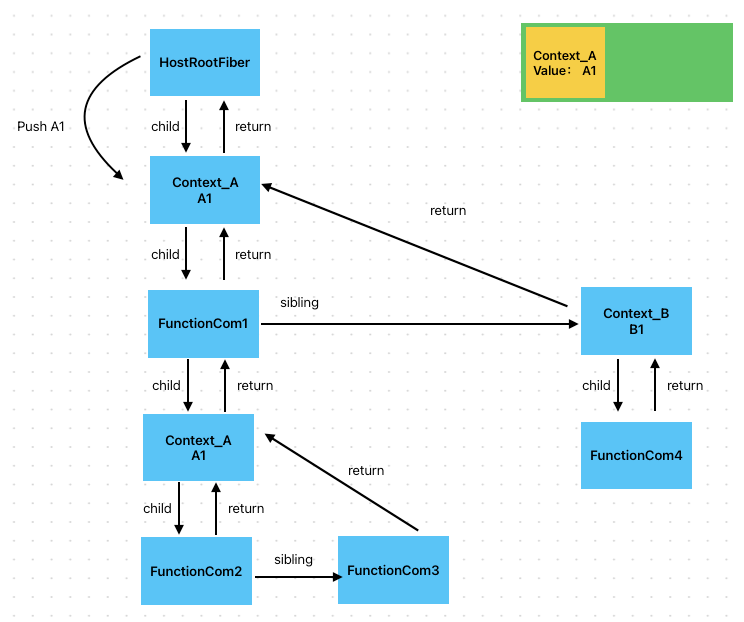
每个Context内部都保存一个最新的值 _currentValue 当便利到一个Context时,都会将value属性传入的最新值爆存在 _currentValue中,并且推入栈
此时,Context_A下面的子节点,都能通过Context_A._currentValue拿到A1值,在函数组件1内,输出Context Value为栈顶的值 A1
继续向下递,遍历到第二层 Context_A的时候,将新的值A2 PUSH STACK 如图
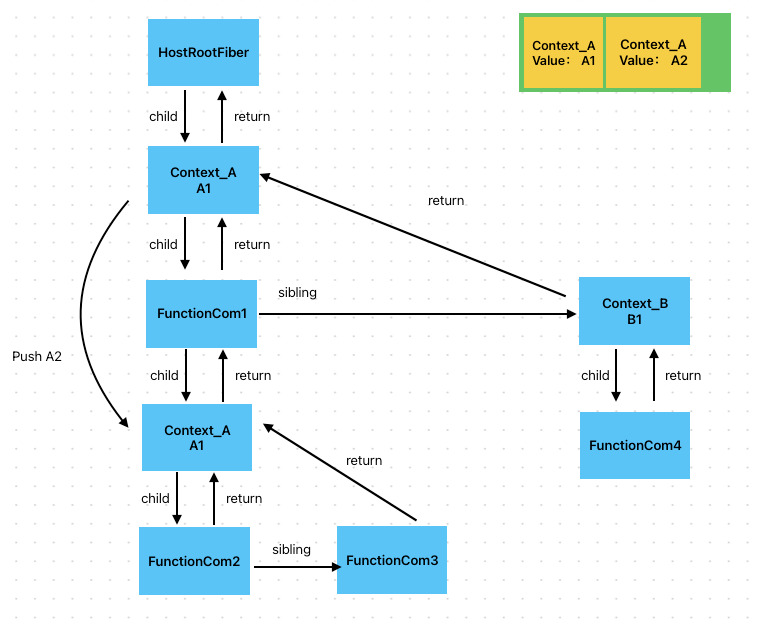
下面的函数组件 2 3 读到的currentValue值就是 A2了,旧的的A1值就无法被 2 3 读取到了,相当于覆盖。
递到叶子结点,开始回溯,经过内层 Context_A 弹出A2,此时把弹出的A1值,赋给 Context_A的_currentValue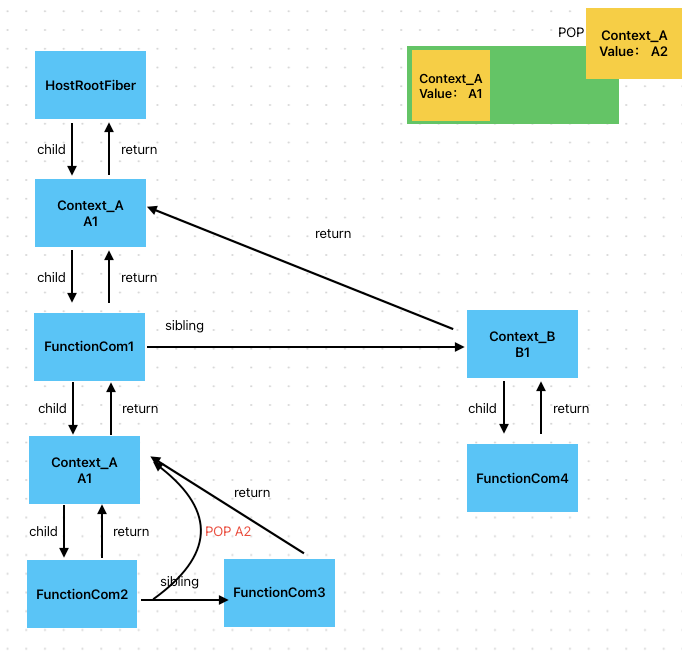
继续向上回归,遍历到组件1的兄弟节点 Context_B 此时把B1 推入栈 并且 B1 赋给 _currentValue
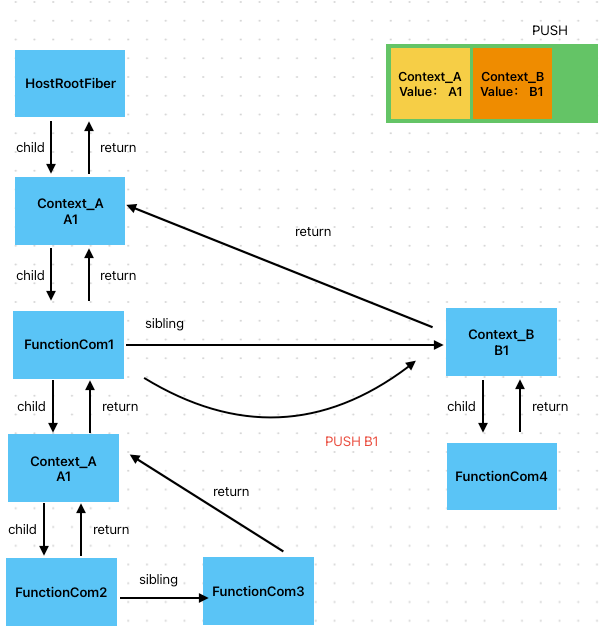
此时 函数组件4 即可拿到 B的值 B1,如果在其中拿Context_A的值取到的也是 Context_A._currentValue = A1,你可以理解为, _currentValue的值是随着遍历变化的,而组件读取Context都是读取其._currentValue值。
最后,回溯,弹出B1 设置 Context_B.current_value = null 弹出A1 设置Context_A._currentValue = null 如下
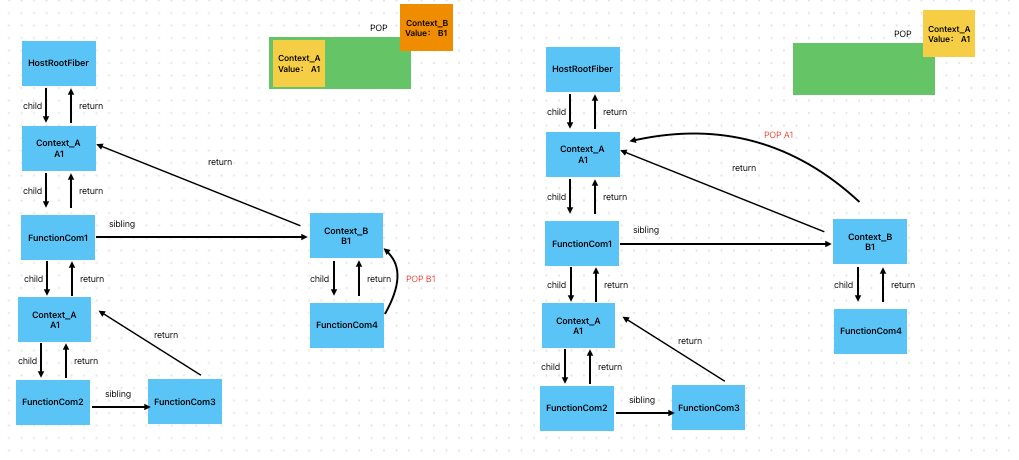
如果你创建Context的时候,通过参数传入初始值:
const Context = createContext(initialValue)
那么._currentValue的默认值就是这个初始化值,而不是null
下面我们简单看一下实现,具体实现你可以看我的git仓库 https://github.com/Gravity2333/My-React/tree/learn
createContext & Context对象
我们使用 createContext创建一个Context对象,其结构如下所示

Context对象包含一个 _currentValue属性 记录最新的Context值
一个Provider属性指向Provider对象
一个Consumer属性指向Consumer对象
Provider和Consumer对象中包含内部属性 _context 指回 Context对象
实现代码如下:
// lib/react/context
import { REACT_CONSUMER_TYPE, REACT_CONTEXT_TYPE, REACT_PROVIDER_TYPE } from "../share/ReactSymbols";export type Context<T> = {$$typeof: symbol | number;Provider: ContextProviderType<T>;Consumer: ContextConsumer<T>;_currentValue: T;
};/** 创建一个Context对象 */
export default function createContext<T>(defaultValue: T): Context<T> {const _context: Context<T> = {$$typeof: REACT_CONTEXT_TYPE,Provider: null,Consumer: null,_currentValue: defaultValue,};// add provider_context.Provider = {$$typeof: REACT_PROVIDER_TYPE,_context,};// add consumer_context.Consumer = {$$typeof: REACT_CONSUMER_TYPE,_context,};return _context;
}
updateContextProvider
这个阶段在Beginwork阶段完成,也就是递的阶段。
这里需要注意,Context对象是不直接生成Fiber对象的,我们平时使用Context的时候也是使用
Context.Provider / Context.Consumer
// react-reconsiler/beginwork.ts
/** 更新ContextProvider */
function updateContextProvider(wip: FiberNode, renderLane: Lane) {const context = wip.type._context;const pendingProps = wip.pendingProps;// 获取最新值const newValue = pendingProps?.value;// 最新值推入 推入Context StackpushContext(context, newValue);// reconcile childreconcileChildren(wip, pendingProps.children);return wip.child;
}
逻辑很简单,拿到最新的值,推入上下文栈,并且协调子节点,和其他类型的节点没什么区别
需要注意,整个Context对象是从 wip.type._context中取得,因为我们在使用 Context.Provider时,通常
<Context.Provider value=""> ... </Context.Provider value="">
等价于
createElement(Context.Provider, {value} ,...)可以看到,整个Provider对象是作为type保存到Element元素中,生成Fiber的时候也会将其爆存在Fiber.type中。我们通过Provider对象._context属性即可获得Context对象!
PushContext & PopContext
简单说一下上下文栈,实现也很简单,如下:
// fiberContext.ts/*** 用来记录上一个context的值*/
let prevContextValue: any = null;/*** 用来记录prevContextValue的栈* 当Context嵌套的时候,会把上一个prevContextValue push到stack中**/
const prevContextValueStack: any[] = [];/** 推入context beginwork调用 */
export function pushContext(context: Context<any>, newValue: any) {// 保存prevContextValueprevContextValueStack.push(prevContextValue);// 保存currentValueprevContextValue = context._currentValue;// 给context设置newValuecontext._currentValue = newValue;
}/** 弹出context completetwork调用 */
export function popContext(context: Context<any>) {/** 从prevContextValue恢复context的值 */context._currentValue = prevContextValue;/** 从prevContextValueStack恢复prevContextValue的值 */prevContextValue = prevContextValueStack.pop();
}可以看到,设置了一个prevContextValue作为中间变量,你可以理解为一个类似缓存的设计,每次Push的时候,都会先将 prevContextValue的值推入栈,并且将最新的值爆存在这个变量中,Pop相反。这个过程也会将最新的值爆存在 Context._currentValue中。
CompleteWork阶段
归的阶段,就是将Context从上下文栈中弹出,如下:
// completeWork.ts
...
case ContextProvider:// pop ContextpopContext(wip.type._context);bubbleProperties(wip);return null;获取Context的值
看了上面的Context对象的结构你就能猜出来,可以通过 Context._currentValue的方式获取Contetx的值,但是一般不希望使用者直接操作内置对象,所以React暴露了两种操作方式
- Context.Consumer
- useContext hook
Consumer
Consumer的使用方式很简单,就是传入一个函数作为children,Consumer会调用这个函数并且传入当前上下文的值,如下
<Context.Consumer>{contextValue => {...}
}</Context.Consumer>在BeginWork阶段,我们需要对Consumer类型的Fiber单独处理,这个由UpdateContextConsumer实现,如下
/** 更新Consumer */
function updateContextConsumer(wip: FiberNode, renderLane: Lane) {const context = wip.type?._context;const pendingProps = wip.pendingProps || {};const consumerFn = pendingProps.children;if (typeof consumerFn === "function") {const children = consumerFn(context?._currentValue);reconcileChildren(wip, children);return wip.child;}return null;
}
原理很简单,就是把children取出来,作为一个函数运行,并且传入当前Context._currentValue
useContext
useContext作为一个hooks函数,在mount和update阶段,都调用readContext函数。
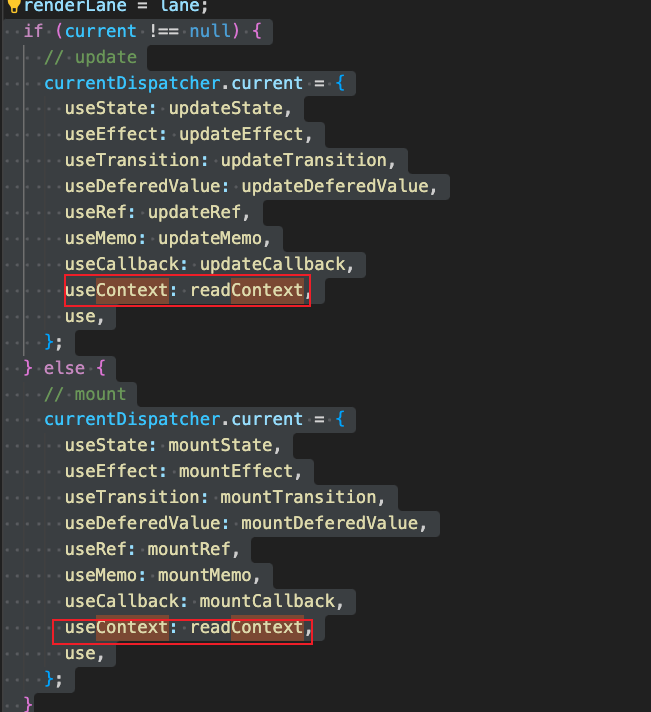
readContext函数调用readContextImpl函数

readContextImpl用来实现读取._currentValue 实现如下, 很简单,就不赘述了
// fiberContext.ts
/** 获取context内容* 还需要生成新的dependencies*/
export function readContextImpl<T>(consumer: FiberNode, context: Context<T>) {if (!consumer) {throw new Error("useContext Error: 请不要在函数组件外部调用hooks");}return context._currentValue;
}
通过上面的逻辑,我们就完成了Context的最基本功能,但是下面还要解决一个性能优化的问题
Context兼容Bailout
在不引入bailout策略的情况下,父节点的内容变动,整个fiber树都会重新渲染。
这种情况下,某个Context变动,整棵树所有的Fiber节点都会重新渲染,能保证Context的更新被所有子节点感知到。
引入bailout策略之后,react每次更新会跳过那些 props type state 不变化的Fiber,那么设想,如果父Context变动,子节点都设置了 memo包裹,那么这些子节点中,即便有读取Context内容的节点也会被bailout策略跳过,因为其 state props type都没变化。
我们需要一种机制,当上层的Context变化的时候,通知其所有订阅的子节点跳过bailout策略。
我们需要在Fiber节点上设置一个属性,记录当前的Fiber节点(函数节点)订阅了哪些Context
我们在Fiber节点上加入 dependences
/** Fiber节点类 */
export class FiberNode {... /** Fiber依赖的Context */dependencies: Dependencies<any>;/** 记录当前Fiber对象依赖的Context* firstContext 依赖的第一个Context* lanes 所有依赖context对应更新的*/
export type Dependencies<T> = {firstContext: ContextItem<T>;lanes: Lanes;
};/** context在dependencies中以链表的方式连接 其链表项为 ContextItem */
export type ContextItem<T> = {context: Context<T>;next: ContextItem<T>;memorizedState: T;
};
dependencies 是一个对象,其中firstContext维护了一个Context线性链表,以及这些Context在本次更新中的lanes
ContextItem记录了当前的Context对象以及next,memorizedState记录了_currentValue
我们需要在一个地方统一的挂载dependencies,我们发现上面实现的readContextImpl可以用来记录当前fiber有哪些订阅的Context, 修改上述readContextImpl实现
/** 获取context内容* 还需要生成新的dependencies*/
export function readContextImpl<T>(consumer: FiberNode, context: Context<T>) {if (!consumer) {throw new Error("useContext Error: 请不要在函数组件外部调用hooks");}// 建立新的dependenciesconst contextItem: ContextItem<T> = {context,next: null,memorizedState: context._currentValue,};// 绑定到consumerif (lastContextDepItem === null) {// 第一个contextItemconsumer.dependencies = {firstContext: contextItem,lanes: NoLanes,};lastContextDepItem = contextItem;} else {// 不是第一个lastContextDepItem = lastContextDepItem.next = contextItem;}return context._currentValue;
}
在每次读取Context值的时候,都会在其Fiber上挂depenencies,在下次更新中,就可以得知Fiber订阅了哪些Context了
在每次便利到Provider时,我们需要对比新的Value是否有变化,这个对比通过Object.is完成,即对比内存地址。
如果没有变化,就bailout跳出,如果变化了,就需要 “通知” 所有订阅了这个Context的组件,这个通知过程由 propagateContextChange完成
/** 更新ContextProvider */
function updateContextProvider(wip: FiberNode, renderLane: Lane) {const context = wip.type._context;const memorizedProps = wip.memorizedProps;const pendingProps = wip.pendingProps;const newValue = pendingProps?.value;const oldValue = memorizedProps?.value;// 推入ContextpushContext(context, newValue);// TODO bailout逻辑if (Object.is(oldValue, newValue) &&memorizedProps.children === pendingProps.children) {/** 两次value相等 并且children不能变化,children变化 哪怕value不变 也要更新下面的Fiber */return bailoutOnAlreadyFinishedWork(wip, renderLane);} else {/** 传播Context变化 */propagateContextChange(wip, context, renderLane);}// reconcile childreconcileChildren(wip, pendingProps.children);return wip.child;
}propagateContextChange的逻辑就是,从当前的Provider开始,开启一个子深度优先遍历,遍历其子树,对于每个Fiber子节点都检查其dependcies,如果包含了当前Context就在其Fiber.lane加入当前更新的优先级lane,这样在遍历到这个节点的时候,就会因为其存在状态 state,不会bailout跳过。 同时,这个遍历的过程向下终止到 叶子结点 或者 相同Context的Provider,因为相同Context Provider下的子节点就不由当前的Provider管理了,实现如下:
/** 传播context变化 */
export function propagateContextChange(wip: FiberNode,context: Context<any>,renderLane: Lane
) {let nextFiber = wip.child;while (nextFiber !== null && nextFiber !== wip) {const deps = nextFiber.dependencies;if (deps) {let contextItem = deps.firstContext;while (contextItem !== null) {if (contextItem.context === context) {// 找到对应的Context 设置lane// 设置fiber和alternate的lanenextFiber.lanes = mergeLane(nextFiber.lanes, renderLane);if (nextFiber.alternate !== null) {nextFiber.alternate.lanes = mergeLane(nextFiber.alternate.lanes,renderLane);}// 从当前Fiber到Provide的Fiber 标记childLanesscheduleContextOnParentPath(nextFiber, wip, renderLane);// 设置deps.lanedeps.lanes = mergeLane(deps.lanes, renderLane);// breakbreak;}else{contextItem =contextItem.next}}} else if (((nextFiber.tag === ContextProvider && nextFiber.type !== wip.type) ||nextFiber.tag !== ContextProvider) &&nextFiber.child !== null) {nextFiber = nextFiber.child;continue;}// 回溯while (nextFiber.sibling === null) {if (nextFiber.return === null || nextFiber.return === wip) {return // 直接return 跳出所有循环}nextFiber = nextFiber.return;}nextFiber = nextFiber.sibling;}
}/** 在parent路径上调度Context* 从当前找到context的节点,到provider节点 标记childLanes*/
function scheduleContextOnParentPath(from: FiberNode,to: FiberNode,renderLane: Lane
) {if (from === to) return;let parentNode = from.return;while (parentNode !== null && from !== to) {parentNode.childLanes = mergeLane(parentNode.childLanes, renderLane);if (parentNode.alternate !== null) {parentNode.alternate.childLanes = mergeLane(parentNode.alternate.childLanes,renderLane);}parentNode = parentNode.return;}
}
我们当前的实现不考虑类组件,所以Context都是在函数组件中完成读取的,这就要我们在开始渲染函数组件之前,先检查这个函数是否包含Context的变化,这个逻辑由 prepareToReadContext完成。
/** 处理函数节点的比较 */
function updateFunctionComponent(wip: FiberNode,Component: Function,renderLane: Lane
): FiberNode {/** 重制dependencies信息 */prepareToReadContext(wip, renderLane);// renderWithHooks 中检查,如果状态改变 则置didReceiveUpdate = trueconst nextChildElement = renderWithHooks(wip, Component, renderLane);if (wip.alternate !== null && !didReceiveUpdate) {// bailout// 重置hookbailoutHook(wip, renderLane);return bailoutOnAlreadyFinishedWork(wip, renderLane);}reconcileChildren(wip, nextChildElement);return wip.child;
}这个函数有两个功能,一个是在进入当前函数节点之前判断当前函数节点是否存在因为Context变动而发生的更新 一个是清空dependcies,准备开始下一轮的Context订阅收集
/** readContext之前的准备工作 每次函数调用之前执行 重新设置dependencies*/
export function prepareToReadContext(wip: FiberNode, renderLane: Lane) {lastContextDepItem = null; // 置空if (wip.dependencies !== null) {if (isSubsetOfLanes(wip.dependencies.lanes, renderLane)) {// 当前函数组件内的Context 包含当前renderLane更新优先级的更新markWipReceiveUpdate(); // 当前函数组件 不能bailout}wip.dependencies = null; // 置空}
}
可以看到,在popagate阶段,会讲所有的Context更新对应的lane合并到 ContextItem的lane上,所以在 prepareToReadContext 中,只需要检查一下当前渲染的lane,是否为ContextItem.lanes的子lane即可判断当前函数组件是否存在因Context变动触发的更新。
最后,对Consumer组件的渲染,我们也进行改造,把通过 context._currentValue读取Context值,统一改成 readContextImpl
/** 更新Consumer */
function updateContextConsumer(wip: FiberNode, renderLane: Lane) {const context = wip.type?._context;const pendingProps = wip.pendingProps || {};const consumerFn = pendingProps.children;if (typeof consumerFn === "function") {const children = consumerFn(readContextImpl(wip,context));reconcileChildren(wip, children);return wip.child;}return null;
}
通过这种方式,我们就可以让Context兼容bailout策略
